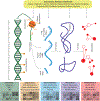Integrating -Omics Approaches into Human Population-Based Studies of Prenatal and Early-Life Exposures
- PMID: 30054820
- PMCID: PMC6187081
- DOI: 10.1007/s40572-018-0204-1
Integrating -Omics Approaches into Human Population-Based Studies of Prenatal and Early-Life Exposures
Abstract
Purpose of review: We present the study design and methodological suggestions for population-based studies that integrate molecular -omics data and highlight recent studies that have used such data to examine the potential impacts of prenatal environmental exposures on fetal health.
Recent findings: Epidemiologic studies have observed numerous relationships between prenatal exposures (smoking, toxic metals, endocrine disruptors) and fetal and early-life molecular profiles, though such investigations have so far been dominated by epigenomic association studies. However, recent transcriptomic, proteomic, and metabolomic studies have demonstrated their promise for the identification of exposure and response biomarkers. Molecular -omics have opened new avenues of research in environmental health that can improve our understanding of disease etiology and contribute to the development of exposure and response biomarkers. Studies that incorporate multiple -omics data from different molecular domains in longitudinally collected samples hold particular promise.
Keywords: Environmental; Epigenomics; Genomics; Metabolomics; Prenatal; Proteomics.
Figures

References
-
- ECHA. Guidance for identification and naming of substances under REACH and CLP. Version 2.1, May 2017. [2018. doi:10.2823/538683. - DOI
-
- USEPA. About the TSCA Chemical Substance Inventory 2018. https://www.epa.gov/tsca-inventory/about-tsca-chemical-substance-inventory (accessed February 2, 2018).
Publication types
MeSH terms
Substances
Grants and funding
LinkOut - more resources
Full Text Sources
Other Literature Sources
Medical
Research Materials

